Tahu tempe bacem is a humble yet iconic dish deeply rooted in the culinary traditions of Yogyakarta and Central Java, Indonesia. Known for its harmonious balance of sweet and savory flavors, this dish epitomizes the rich cultural heritage of Javanese cuisine. At its core, tahu tempe bacem showcases the ingenious use of simple, affordable ingredients like tofu and tempeh, which are transformed into a flavorful delight through a unique cooking technique called bacem. This dish holds a special place in the hearts of many Indonesians, often evoking memories of home-cooked meals and bustling traditional markets.
Table of Contents

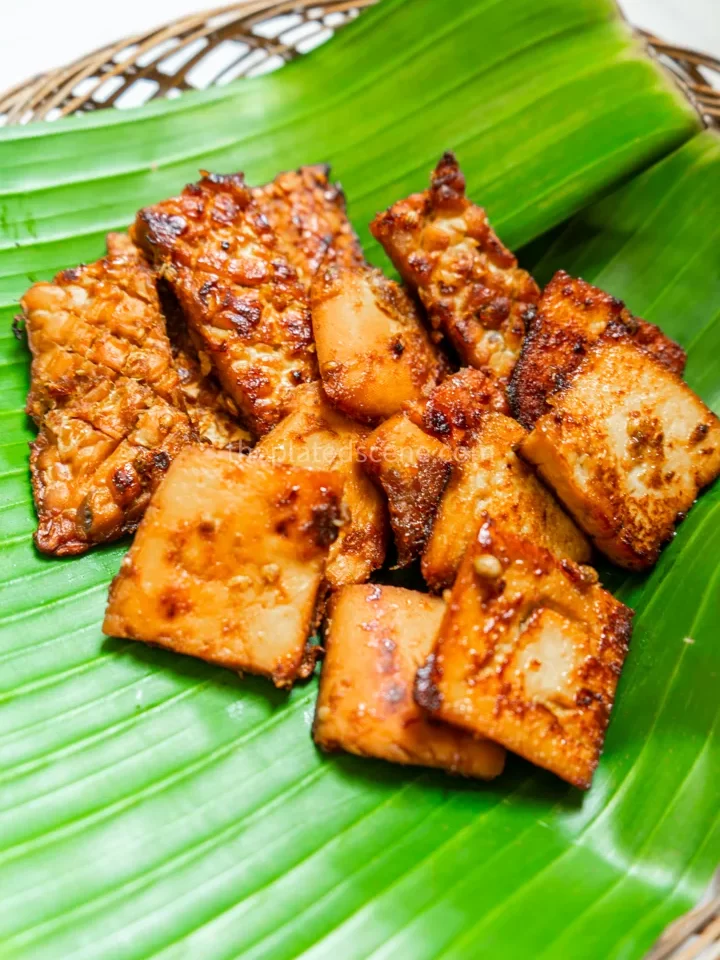
A Dish Steeped in Tradition
The roots of tahu tempe bacem can be traced back to Central Java, where the Javanese culinary philosophy of incorporating sweetness into dishes is a hallmark. This sweetness is often derived from gula Jawa (palm sugar), a traditional sweetener that lends a rich caramelized flavor to the dish. In addition to its culinary appeal, tahu tempe bacem represents the resourcefulness of Javanese cooks who turned simple soy-based ingredients into a beloved dish.
My connection to tahu tempe bacem runs deep. My mother’s hometown is Surakarta, more commonly known as Solo, a charming city in Central Java where culinary traditions thrive. Growing up, our annual visits to Solo were incomplete without a trip to the bustling traditional markets. Among the array of street food, tahu, and tempe bacem stood out as a favorite. Vendors displayed golden-brown tofu and tempeh, their surfaces glistening with caramelized palm sugar, tempting passersby with their sweet and savory aroma.
Regional Variations: Jadah Tempe in Yogyakarta
While Solo is renowned for its tahu tempe bacem, another dish variation has gained fame in the neighboring region of Yogyakarta. Known as jadah tempe, this dish pairs bacem tempeh with jadah, a savory glutinous rice cake made with coconut milk. A specialty of the cool, mountainous region of Kaliurang, jadah tempe exemplifies the Javanese love for contrasting textures and flavors. The creamy, slightly salty jadah complements the sweet and caramelized tempeh, creating a dish that is as comforting as it is unique. Initially, jadah tempe was not widely popular due to its rustic appearance, but its incredible flavor soon earned it a loyal following.
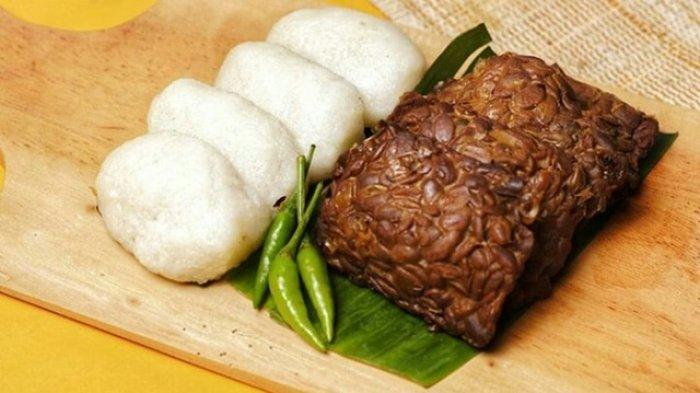
A Nostalgic Taste of Home
Tahu tempe bacem isn’t just a dish for me—it’s a cherished part of my family history. My mother, who grew up in Solo, often prepared this dish when I was a child. Compared to other Javanese recipes, which can be pretty intricate, her tahu tempe bacem recipe stood out for its simplicity. The process involved two key steps: first, braising the tofu and tempeh in a fragrant mixture of spices, palm sugar, and water until the flavors were deeply infused; second, frying or baking the braised pieces to achieve a caramelized surface. The result was always irresistible, a dish that brought comfort and joy to our family table.
Adapting Tradition Abroad
Now that I live in Singapore, I no longer have access to Solo’s street vendors or markets. My mother, who remains in Indonesia, is no longer just a call away when I crave her tahu tempe bacem. Determined to keep this cherished tradition alive, I’ve taken it upon myself to recreate her recipe. Through trial and error, I’ve learned to perfect this dish, and I’m excited to share the recipe with you so you, too, can experience the magic of tahu tempe bacem.
What is Tempeh? A Superfood with Javanese Roots
At the heart of tahu tempe bacem is tempeh, a fermented soybean product that has gained international recognition as a plant-based superfood. Pronounced “tem-pay,” tempeh originated in Indonesia and has been a staple of the Javanese diet for centuries. Its rich umami flavor, nutty undertones, and chunky texture make it a versatile ingredient that pairs beautifully with the sweet-savory bacem method.
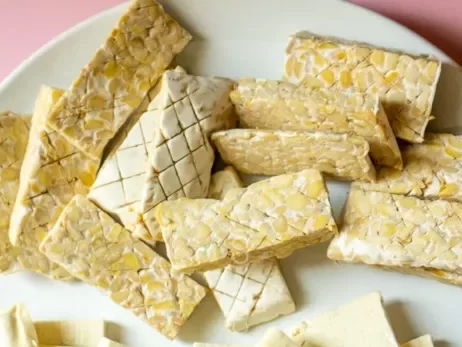
Tempeh is often compared to tofu, but there are distinct differences. While tofu is made by curdling soy milk into a soft, smooth texture, tempeh is created by fermenting whole soybeans and pressing them into a firm cake. This fermentation process enhances its nutritional value and gives it a unique flavor profile. Tempeh is celebrated for being a complete protein, providing all nine essential amino acids, and being high in vitamins, minerals, and fiber. For vegans and vegetarians, tempeh is a powerhouse ingredient that supports a healthy, balanced diet.
What is Bacem? The Secret to Sweet and Savory Perfection
The word bacem refers to a traditional Javanese cooking technique that involves braising food in a flavorful blend of spices and palm sugar. This method transforms simple ingredients like tofu and tempeh into a flavorful dish. The bacem process infuses the ingredients with a sweet-savory essence, thanks to key seasonings such as garlic, coriander, galangal, and gula Jawa.
Patience is the key to achieving the perfect bacem. The tofu and tempeh are simmered over low heat, allowing the flavors to meld and intensify. Once the braising liquid has been absorbed, the pieces are fried or baked to create a caramelized exterior. The result is a dish that is not only delicious but also versatile—you can enjoy it as a snack, a side dish, or a main course paired with rice and vegetables.
Versatility Beyond Tofu and Tempeh
While tofu and tempeh are the most traditional ingredients for bacem, the technique is highly adaptable. Creative cooks have recently applied the bacem method to chicken (ayam bacem), mushrooms, and plant-based meat substitutes. These variations retain the essence of bacem while catering to diverse dietary preferences. If you’re feeling adventurous, don’t hesitate to experiment with other ingredients and discover new ways to enjoy this classic Javanese dish.
What are the Ingredients for Tahu Tempe Bacem?
When preparing tahu tempe bacem, it’s essential to use the right ingredients to capture the authentic flavors of this iconic Javanese dish. Each ingredient plays a critical role, from tofu and tempeh as the base to the aromatic spices and sweeteners that bring the dish to life. Let’s explore the components in detail, with tips and insights to ensure your tahu tempe bacem turns out perfectly.
1. Tofu and Tempeh: The Stars of the Dish
The primary ingredients for this recipe are tofu (tahu) and tempeh (tempe), both beloved staples in Indonesian cuisine. Their textures and flavors are beautifully transformed through the bacem process.
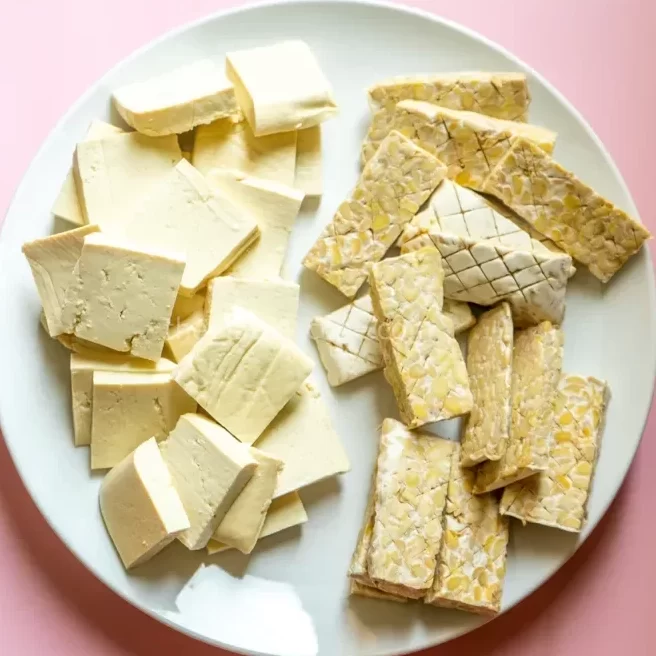

Tofu
For this dish, it’s best to use firm tofu, as it holds up well during the braising process. Firm tofu absorbs the seasoning effectively without breaking apart. Here are the cutting recommendations:
- Traditional size (my mother’s preference): 4cm x 4cm x 2cm
- Thinner version (for more crunch): 3cm x 3cm x 1cm
The thinner size creates a larger surface area, resulting in a crispier fried exterior. However, be gentle during braising to avoid breaking the tofu if you choose this version.
Tempeh
Use fresh, high-quality tempeh that is compact and free of dark spots. The traditional tempeh cut ensures even cooking and a better infusion of flavors:
- Traditional size: 4cm x 2cm x 2cm
- Thinner version: 4cm x 2cm x 1cm
For tempeh, score or lightly slice the surface of each piece. This step helps the seasoning penetrate more effectively, resulting in a richer flavor.
2. Blended Aromatics: Shallots, Garlic, and Coriander Seeds
The heart of Javanese cuisine lies in its aromatic spice blends. In tahu tempe bacem, shallots, garlic, and coriander seeds form the foundational flavor profile.

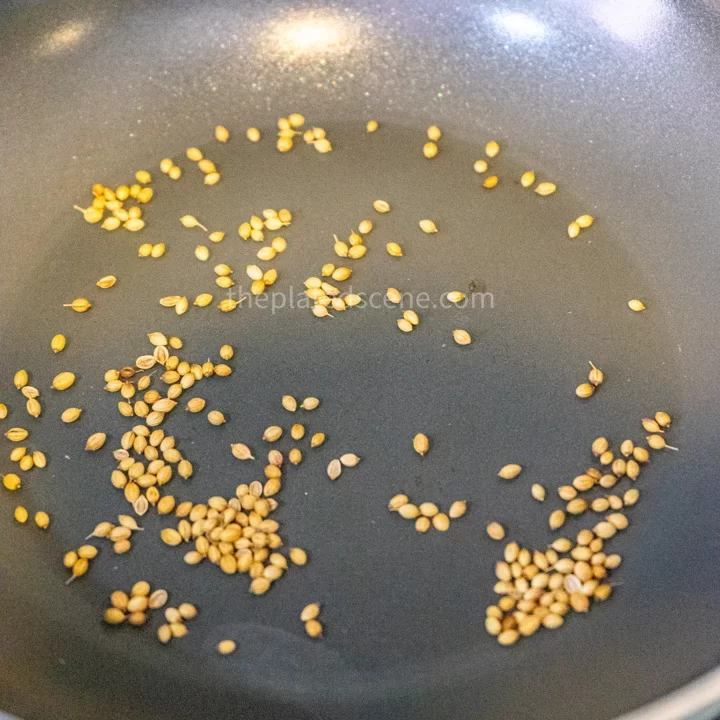
Shallots and Garlic
These two ingredients are the dynamic duo of Indonesian cooking. Rarely will you find a recipe without both.
- Shallots: Provide a mild, slightly sweet flavor that balances the dish.
- Garlic: Adds depth and a pungent, savory note.
The recommended ratio for this recipe is two parts shallots to 1 part garlic, ensuring a balanced, nuanced flavor.
Coriander Seeds
Dry roasting coriander seeds before blending enhances their natural oils and intensifies their citrusy, slightly curry-like aroma. Avoid using pre-ground coriander, as it loses potency quickly. If you don’t have coriander seeds, you can substitute them with cumin, but note that cumin has a more robust flavor. Store coriander seeds in an airtight container for up to a year to keep them fresh.
3. Key Bacem Ingredients: Galangal, Bay Leaves, and Palm Sugar
These ingredients give bacem its signature sweet-savory flavor and aroma.
Galangal Root
A relative of ginger and turmeric, galangal has a sharp, citrusy, and slightly pine-like flavor. While ginger is a common substitute, galangal’s unique taste is hard to replicate.
- Preparation Tip: Slice the galangal root to increase its surface area, allowing it to release more flavor during braising tahu tempe bacem. Since galangal is fibrous, it is not blended but simmered in the braising liquid and removed before serving.
Bay Leaves
Though often debated, bay leaves add subtle layers of woodsy, eucalyptus-like flavor that enhance the dish. In Javanese cooking, they are indispensable for a more authentic taste.
Palm Sugar (Gula Jawa)
Palm sugar is the star sweetener in tahu tempe bacem, contributing a deep, caramel-like sweetness that balances the savory elements.
- Preparation Tip: Since palm sugar typically comes in large blocks, shave or chop it into smaller pieces to help it dissolve more easily during cooking. If palm sugar isn’t available, you can substitute it with coconut sugar or dark brown sugar, though the flavor won’t be as rich.
4. Seasonings: Salt, Mushroom Stock, and Optional Enhancements
Seasonings tie everything together, ensuring a well-rounded flavor profile.
- Salt: A small but essential ingredient to balance the sweetness of the palm sugar. Adjust to taste, but be cautious not to over-salt, as the dish’s charm lies in its subtle sweetness.
- Mushroom Stock: This vegetarian-friendly seasoning enhances the umami of the tahu tempe bacem. It’s a great alternative to traditional chicken or beef stock, maintaining the dish’s integrity while boosting its savory depth.
5. Water: The Unsung Hero
While it may seem simple, the water used during braising plays a critical role in infusing the tofu and tempeh with the flavors of aromatics, spices, and palm sugar. Use just enough to cover the tofu and tempeh, ensuring they’re evenly submerged. As the liquid reduces, it creates a flavorful glaze that clings to the surface of the tofu and tempeh.
6. Optional Ingredients for Variation
While traditional tahu tempe bacem sticks to its core ingredients, you can experiment with additional elements to personalize the dish:
- Coconut Water:
In some regions, coconut water is used instead of regular water during braising. This adds a subtle sweetness and richness to the dish. - Chili Peppers:
For a touch of heat, add whole or sliced chili peppers to the braising liquid. This creates a sweet-spicy version of tahu tempe bacem. - Turmeric:
A pinch of turmeric can enhance the color of the dish, giving the tofu and tempeh a golden hue.
7. Quality Matters: Tips for Ingredient Selection
To achieve the best results, prioritize quality when selecting your ingredients:
- Tofu and Tempeh: Look for fresh, locally sourced products if possible. Avoid tofu or tempeh with an overly soft or crumbly texture.
- Palm Sugar: Choose pure, unadulterated palm sugar without added fillers or artificial coloring.
- Spices: Use whole spices whenever possible, as they retain their flavors longer than pre-ground alternatives.
8. Storing and Prepping Ingredients
If you’re preparing tahu tempe bacem in advance, proper storage of ingredients is essential:
- Tofu and Tempeh: Store tofu in water in an airtight container and change the water daily. Tempeh can be refrigerated for up to a week or frozen for extended storage.
- Palm Sugar: Keep in an airtight jar in a cool, dry place.
- Blended Aromatics: Prepare the shallot, garlic, and coriander blend in bulk and store in the refrigerator for up to three days.
How to Make Tahu Tempe Bacem: A Detailed Guide
Making tahu tempe bacem involves three distinct steps: preparation, braising, and frying/baking. Each step is crucial to achieving the rich, sweet-savory flavors and delightful textures that make this dish a beloved staple of Javanese cuisine. Let’s explore these steps to help you master this recipe.
Step 1: Preparation – Setting the Stage
Preparation is the foundation of a successful tahu tempe bacem. The key here is to ensure all ingredients are ready and adequately prepped to allow the cooking process to flow smoothly.
Cutting the Tofu and Tempeh
- Tofu: Use firm tofu to prevent it from breaking during cooking. Cut into:
- Traditional size: 4cm x 4cm x 2cm
- Thinner size (for crispier results): 3cm x 3cm x 1cm
- Tempeh: Choose fresh tempeh with no dark spots. Cut into:
- Traditional size: 4cm x 2cm x 2cm
- Thinner size: 4cm x 2cm x 1cm
- Scoring Tempeh: Lightly score or make shallow cuts on the surface of each tempeh piece. This step ensures the seasoning penetrates the tempeh, enhancing the overall flavor.
Blending Aromatics
- Combine garlic, shallots, and coriander seeds in a food processor or immersion blender (here is the Amazon link for the type I use).
- Use a mortar and pestle if you prefer the traditional method. Crushing the ingredients manually can intensify their natural flavors.
- Texture Tip: It’s okay if the coriander seeds remain slightly coarse, as they add a rustic charm to the dish.
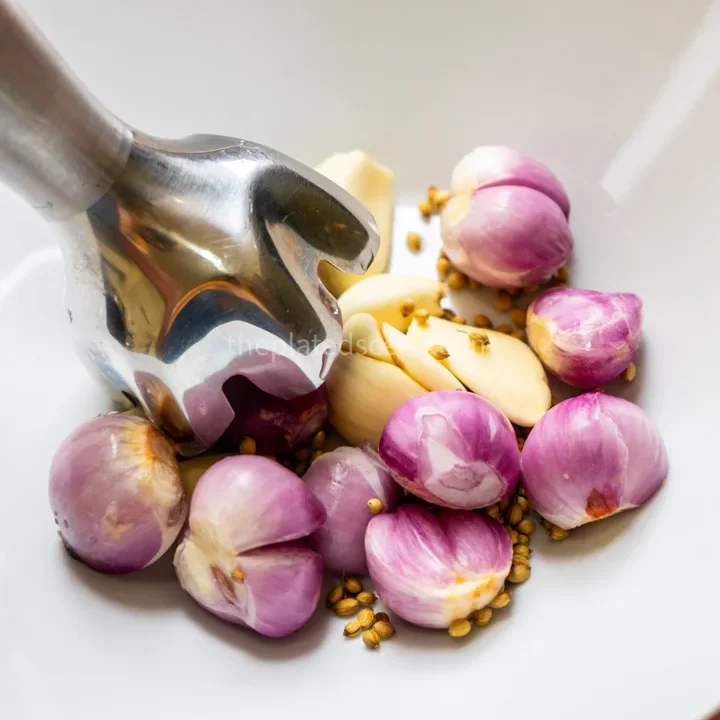
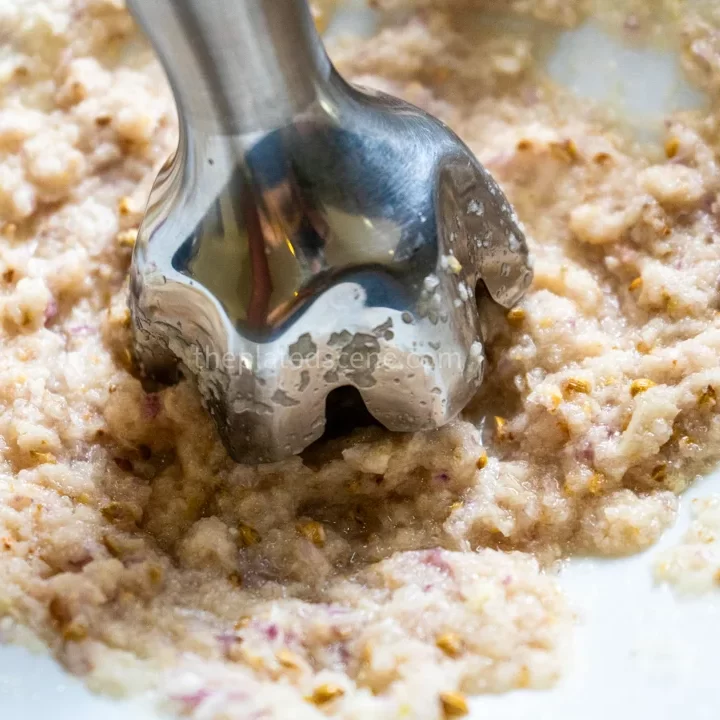
Preparing Additional Ingredients
- Galangal: Slice the galangal into thin pieces to increase its surface area, allowing more flavor to infuse during braising.
- Palm Sugar: Shred or chop palm sugar into small chunks to help it dissolve quickly during cooking.
- Bay Leaves: Have them ready to add a subtle, earthy aroma to the dish.
Organize Your Tools and Ingredients
Ensure you have a suitable pan or pot for braising and utensils like a spatula or tongs to gently handle the tofu and tempeh. This preparation avoids unnecessary interruptions during cooking.
Step 2: Braising – Infusing Flavors
Braising is the most critical step in making tahu tempe bacem. This process allows the tofu and tempeh to absorb the sweet-savory seasoning, creating the dish’s signature taste.
Prepare the Braising Liquid
- Combine the blended aromatics (garlic, shallots, and coriander seeds) in a large pan with galangal slices, bay leaves, palm sugar, salt, and mushroom stock.
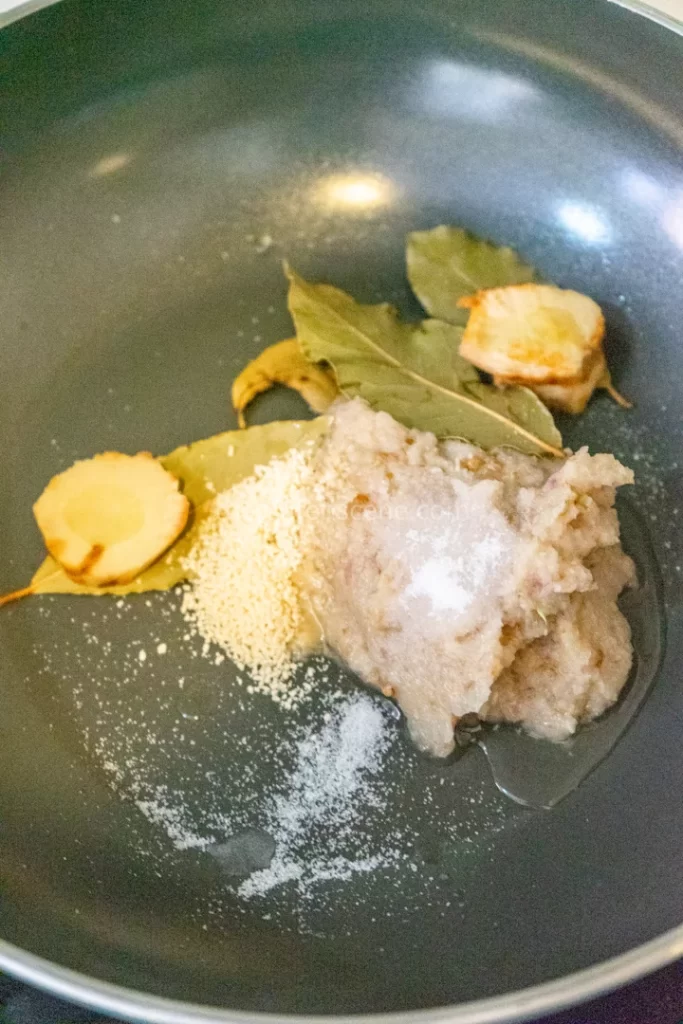
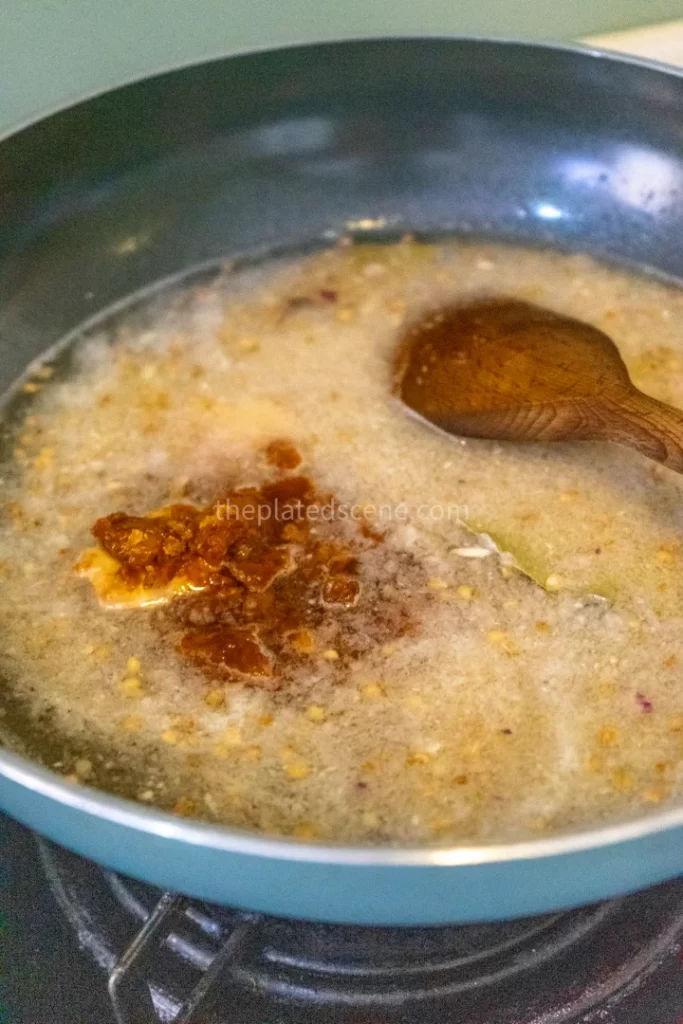
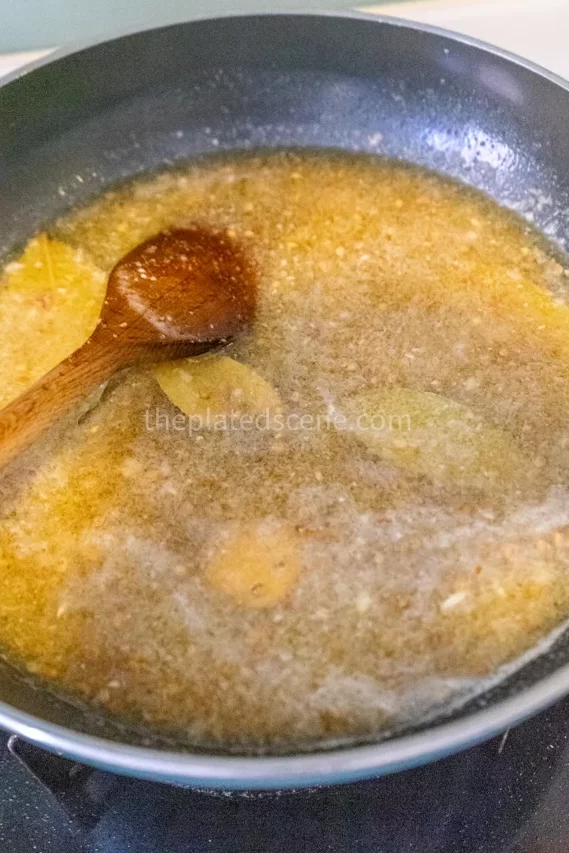
- Add 500 ml of water and stir until the palm sugar dissolves completely. The liquid should have a slightly sweet and savory aroma.
Add Tofu and Tempeh
Arrange the tofu and tempeh pieces in the pan, fully submerging them in the braising liquid.
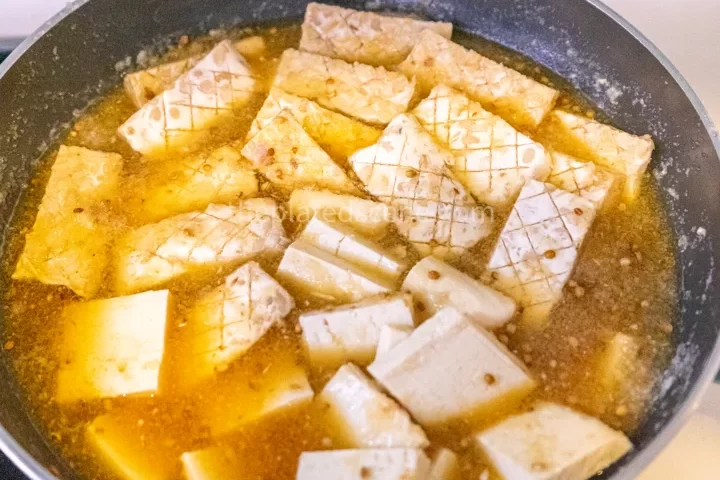
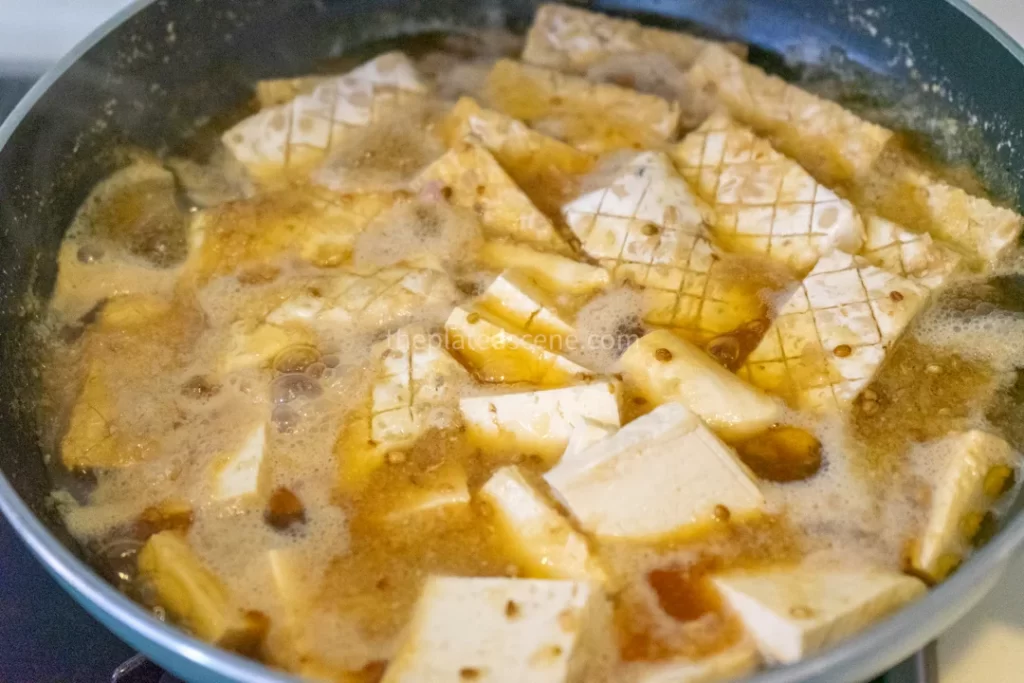
Mix more water gently to distribute the seasoning evenly if necessary. Avoid overcrowding the pan to allow even cooking.
Simmer Over Low Heat:
Bring the mixture to a gentle simmer over low heat. Low heat ensures the tofu and tempeh absorb the flavors gradually, resulting in a deeper infusion.
Stir gently and occasionally flip the tofu and tempeh to coat them evenly with the seasoning. Use a spatula or tongs to avoid breaking them.
Partially Cover the Pan:
Cover the pan with a lid, leaving a small gap to allow steam to escape. This step concentrates the flavors while preventing the liquid from boiling over.
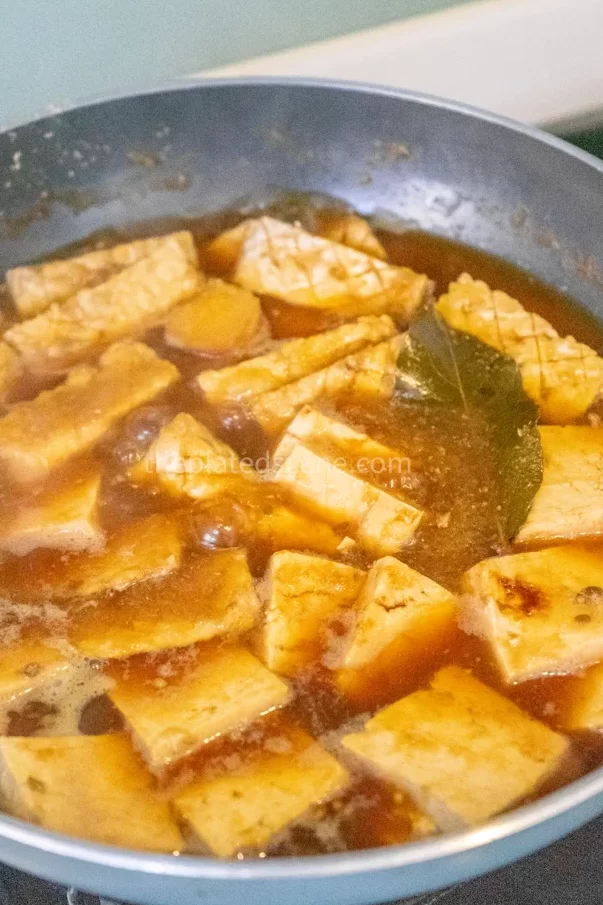
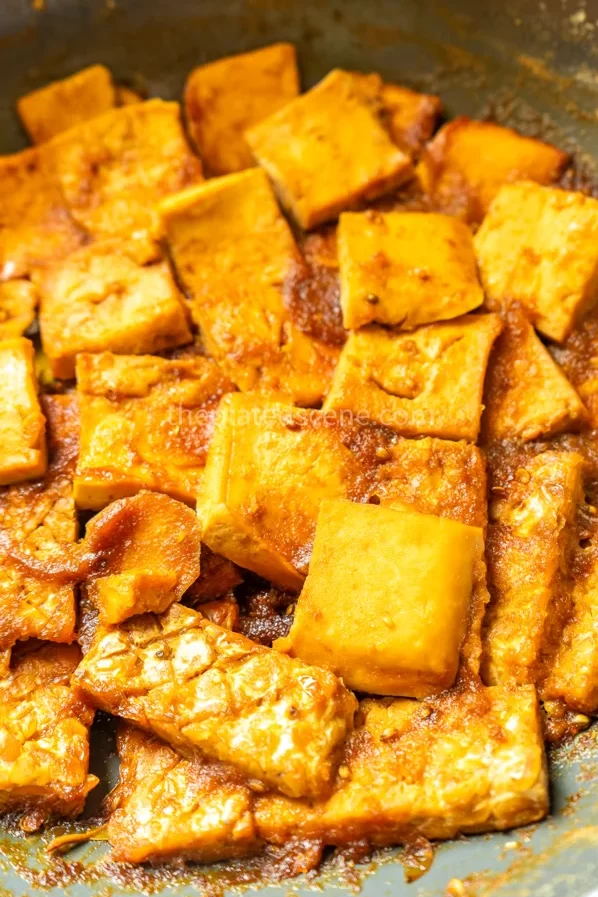
Monitor the Process:
As the liquid reduces, it will thicken and darken due to the caramelization of palm sugar. This stage creates the signature glaze on the tofu and tempeh.
Continue braising until the liquid evaporates and the tofu and tempeh are well-coated with the seasoning.
Cool and Store:
Remove the pan from the heat and allow the tofu and tempeh to cool.
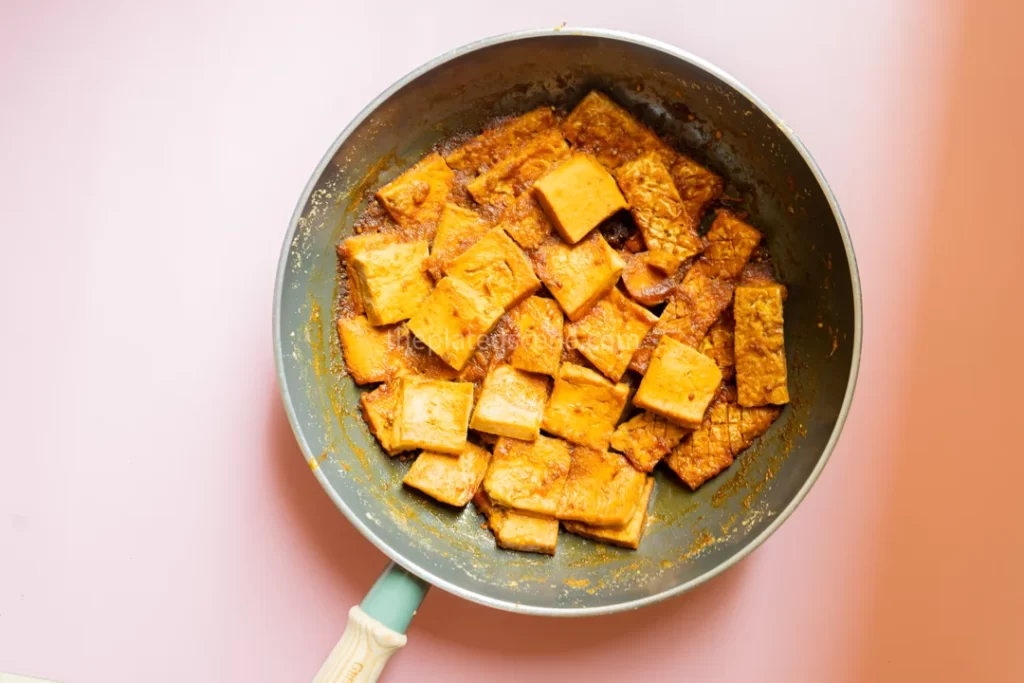
If you’re not serving the tahu tempe bacem immediately, transfer the pieces to an airtight container and refrigerate for up to 3 days. This allows the flavors to develop further, making the dish even more delicious when reheated.
Step 3: Frying or Baking – The Final Touch
The final step brings out the best in tahu tempe bacem by caramelizing the surface, adding a delightful crunch contrasting with the tender interior.
Choose Your Cooking Method
Depending on your equipment and preference, you can fry, air-fry, or bake the tofu and tempeh:
Air-Frying
- Preheat the air fryer to 180°C (356°F).
- Arrange the tofu and tempeh in a single layer in the air fryer basket.
- Cook for 5–10 minutes or until the surfaces turn golden brown and slightly crispy. Air-frying is a healthier alternative that retains the dish’s flavor and texture.
Pan-Frying
- Heat a thin layer of oil in a non-stick skillet over medium heat.
- Fry the tofu and tempeh, flipping occasionally, until all sides are golden brown and caramelized.
- Remove and drain excess oil on paper towels.
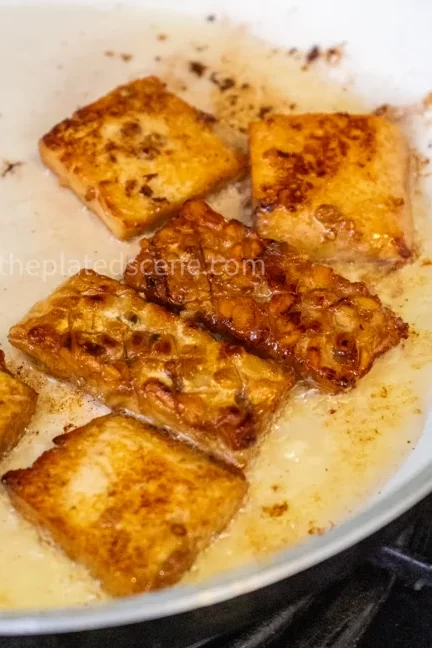

Baking
- Preheat your oven to 180°C (356°F).
- Line a baking tray with parchment paper and arrange the tofu and tempeh pieces in a single layer.
- Bake for 10–15 minutes, flipping halfway through, until they develop a crispy exterior.
Serving Suggestions
Arrange the crispy tahu tempe bacem on a plate and garnish with fried shallots or fresh herbs for added aroma and texture. Serve as a snack or a main meal with steamed rice, stir-fried vegetables, or sambal (Indonesian chili paste).
Tips for Success
- Be Patient: Braising over low heat takes time but ensures that the tofu and tempeh absorb all the rich flavors. Avoid rushing this step.
- Use Fresh Ingredients: High-quality tofu, tempeh, and palm sugar significantly impact the final dish’s taste.
- Customize the Recipe: Adjust the sweetness or saltiness to suit your preference by tweaking the amount of palm sugar and salt.
- Try Coconut Water: Substitute water with coconut water during braising for an enhanced flavor.
Storing Tahu Tempe Bacem: Preserve the Flavor for Longer Enjoyment
Storing tahu tempe bacem properly ensures you can enjoy this flavorful dish conveniently, whether as a quick snack, a side dish, or part of a larger meal. Here’s how you can effectively store your tahu tempe bacem to retain its delicious taste and texture.
1. Storing After Braising
After completing the braising step, your tofu and tempeh are fully cooked but not yet caramelized. This stage is perfect for storage if you plan to fry or bake them later.
- Refrigeration:
- Allow the braised tofu and tempeh to cool completely before storing. Placing hot food in the refrigerator can cause condensation, affecting the texture and flavor.
- Transfer the cooled pieces to an airtight container. Layer them neatly to avoid breaking the tofu or tempeh.
- Store in the refrigerator for up to 3–4 days. The sweet-savory flavors will deepen, making them even tastier when reheated.
- Freezing:
- If you want to keep your tahu tempe bacem longer, freezing is a great option.
- Place the cooled tofu and tempeh pieces in a freezer-safe container or ziplock bag. To prevent sticking, separate layers with parchment paper.
- Frozen tahu tempe bacem can last up to 2 months.
- Reheating Tip: Thaw frozen tofu and tempeh in the refrigerator overnight before frying, air-frying, or baking.
2. Storing After Frying or Baking
Once you’ve fried or baked your tahu tempe bacem, consuming it fresh for the crispiest texture is best. However, if you have leftovers, you can store them with a few precautions.
- Refrigeration:
- Let the fried or baked tofu and tempeh cool completely.
- Please place them in an airtight container lined with a paper towel to absorb excess moisture.
- Store in the refrigerator for up to 2–3 days.
- Reheat by lightly frying, air-frying, or baking to restore the crispiness.
- Freezing:
- Freezing already fried or baked tahu tempe bacem is not recommended as it may lose its crisp texture upon reheating. If you must freeze it, follow the same process as braised tofu and tempeh and reheat them using an air fryer or oven for the best results.
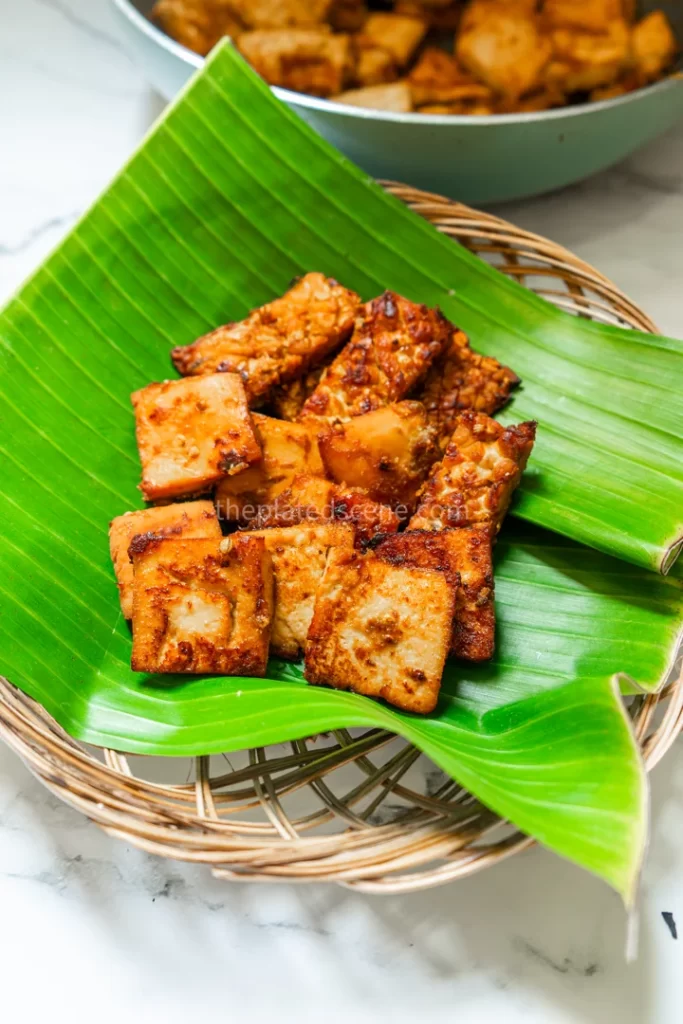
Conclusion: Your Turn to Try Tahu Tempe Bacem!
Tahu tempe bacem is more than just a dish—it celebrates Indonesia’s rich culinary heritage. Whether you’re familiar with Javanese cuisine or discovering it for the first time, this recipe is a perfect gateway to its comforting flavors.
Ready to give it a try? Share your experience in the comments below, and don’t forget to enjoy the sweet-savory delight of tahu tempe bacem with your loved ones. Happy cooking! 🍴
Other recipes that you might like
- Spiced Tofu in Banana Leaves (Pepes Tahu)
- Vegan Mushroom Satay with Peanut Sauce
- Vegan Mie Goreng (Fried Noodle)


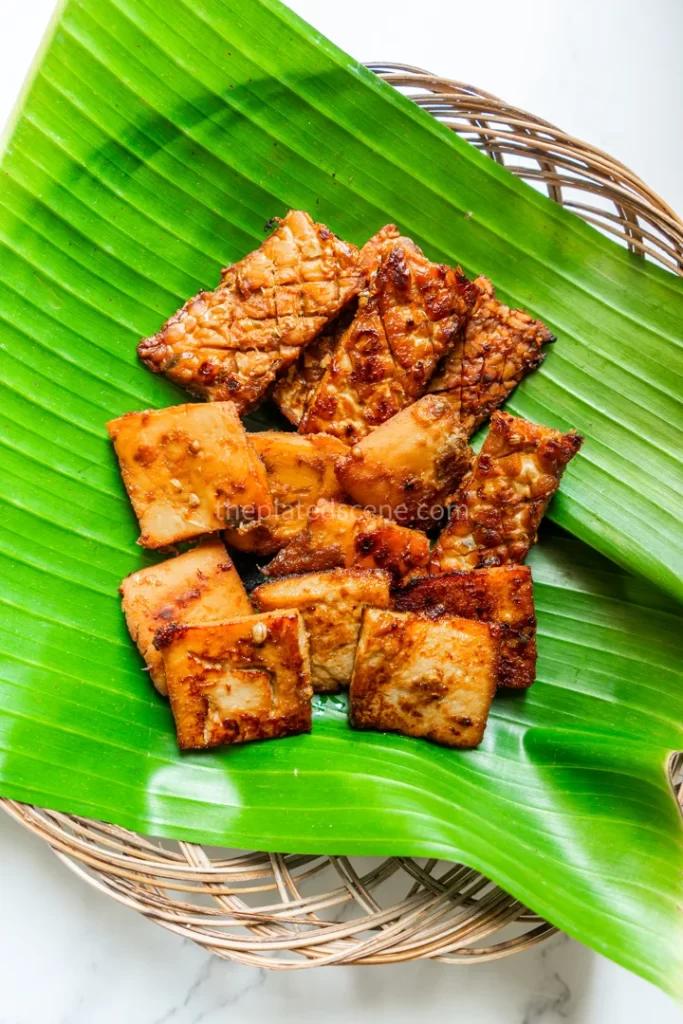
1 comment
[…] Gulai Nangka (Jackfruit Curry) Recipe Spiced Tofu in Banana Leaves (Pepes Tahu) –… Tofu Tempe Bacem Recipe (Braised Tempe and Tofu)… Vegan Mushroom Satay with Peanut Sauce – Easy… How to Cook Indonesia Vegan […]
Comments are closed.